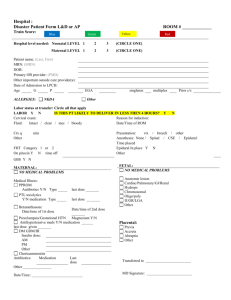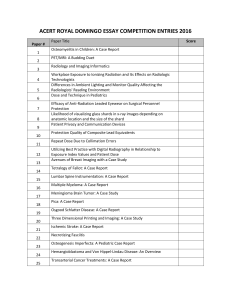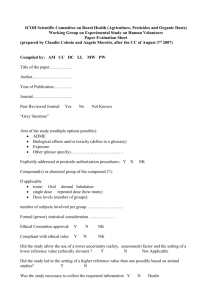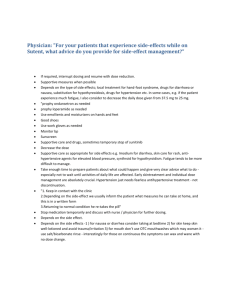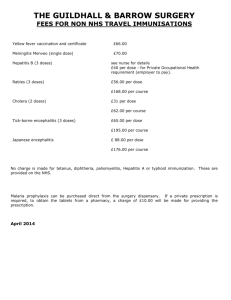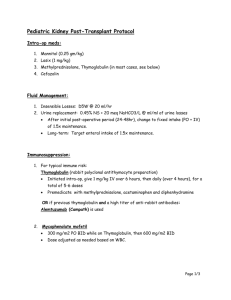Appendix Transplant Protocols
advertisement
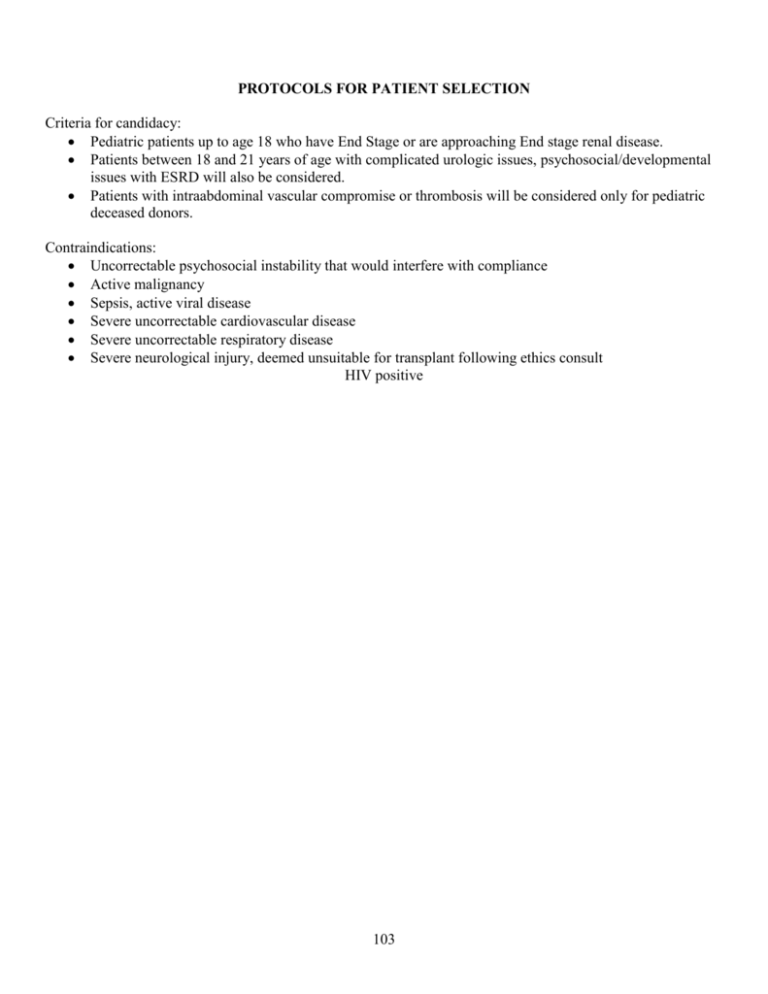
PROTOCOLS FOR PATIENT SELECTION Criteria for candidacy: Pediatric patients up to age 18 who have End Stage or are approaching End stage renal disease. Patients between 18 and 21 years of age with complicated urologic issues, psychosocial/developmental issues with ESRD will also be considered. Patients with intraabdominal vascular compromise or thrombosis will be considered only for pediatric deceased donors. Contraindications: Uncorrectable psychosocial instability that would interfere with compliance Active malignancy Sepsis, active viral disease Severe uncorrectable cardiovascular disease Severe uncorrectable respiratory disease Severe neurological injury, deemed unsuitable for transplant following ethics consult HIV positive 103 104 Post-Transplant Primary Immunosuppression Protocol Induction Agents a. Patients with low sensitization risk (peak PRA < 20%, first transplant). i. These patients will receive Zenapax [dacluzimab], administered as follows: 1. Steroid-Based: Zenapax® dose of 1 mg/kg pre-transplant followed by 1 mg/kg at weeks 2, 4, 6, and 8. Patients receive a total of 5 doses until 2 months post-transplantation. 2. Steroid-Free: Zenapax® dose of 2 mg/kg pre-transplant followed by 1 mg/kg at weeks 2, 4, 6, 8, 11, 15, 19, and 23. Patients receive a total of 9 doses until 6 months posttransplantation. 3. If a transfusion >/= 15 mL/kg of packed red blood cells is required within the first 5 days post-transplant, give an additional 1 mg/kg dose of Zenapax. b. Patients with high sensitization risk (peak PRA > 20%, history of multiple blood transfusions, repeat transplant, history of pregnancy, selected deceased donor recipients requiring tacrolimus minimization). i. These patients will receive thymoglobulin, administered as follows. 1. Similar usage in Steroid-Free and Steroid-Based – minimum 3 days of thymoglobulin. 2. Pre-transplant dose 1.5mg/kg x1, post-transplant dose 1.5mg/kg q day for 3-7 days. 3. Titrate dose to target CD3 counts of 0 during treatment. Prograf® (tacrolimus) Oral Prograf® will be administered pre-operatively to recipients > 5 years of age at a starting dose of 0.1 mg/kg/dose BID for living donor recipients and 0.1 mg/kg/dose QD for cadaveric donor recipients. Recipients < 5 years of age will be dosed with 0.15 mg/kg/dose BID for living donor recipients and 0.15 mg/kg/dose QD for cadaveric donor recipients. Post operatively, the oral dose will be 0.07 mg/kg/dose BID adjusted subsequently to achieve target levels. Patients should be NPO 1 hour before and after Prograf dosing. Target trough tacrolimus levels: Days Target Trough Levels Day 0 to Week 2 post transplant (day 0 to14 days) 12-15 ng/mL Day 15 to week 8 post transplant (days 15 to 56) 10-12 ng/mL Week 9 to week 12 (days 57 to 84) 7-10 ng/mL After 12 weeks ( ≥85 days post transplant) 5-7 ng/mL If levels are persistently towards the lower end of the target range, consider 20% dose increase. If level is below target range, consider 1-time 50% dose increase and maintenance 20% dose increase and check levels (round up to the nearest 0.5mg increment if on pills). If evidence of substantive tacrolimus toxicity is found on 12, or 24-month protocol biopsy (>20% tubular atrophy and interstitial fibrosis, medial hyalinosis, widespread isometric vacuolization, high Stanford DT score) consider reduction of tacrolimus target to 4-6ng/mL. CellCept® (MMF) CellCept® is administered intravenously at 1200 mg/m2/day in 2 divided doses. It should be administered pre-operatively and continued IV for the first 48 hours. Following this, MMF at a dose of 900 mg/m2/day in 2 divided doses should be administered until week 2, orally when tolerated. The dose may be reduced to 600 mg/m2/day in 2 divided doses if full dose is not tolerated. This dose may be reduced to 400 mg/m2/day transiently in 2 divided doses if full dose is not tolerated, [diarrhea, persistent leucopenia despite GCSF treatment]. Oral MMF may be taken with food to minimize GI toxicity. In patients who can take tablets, consider Myfortic (180mg Myfortic = 250mg CellCept) if there is persistent GI toxicity. Trough MPA levels between 2 to 4 mcg/mL in children >10 years old suggest drug efficacy. If levels higher than 4mcg/mL are found, dose reduction may be considered. Children <10 years old frequently have lower levels, and dosing in these patients should be based only on BSA. 105 Azathioprine [Imuran] Persistent gastrointestinal symptoms in infant recipients immediately post-transplant may require temporary switch from CellCept to Imuran. Imuran is loaded at 3mg/kg x1 and then maintained at 2mg/kg q day. CellCept should be rechallenged in these patients at 3 months post-transplant. It is recommended to transition over 1-2 weeks from Imuran back to CellCept with 25% dose changes for both medications. Incremental changes to take place over 2-3 days each. Rapamune® (sirolimus) Sirolimus may be administered as an alternative to MMF, if subject re-challenge with MMF fails due to MMF intolerance (usually due to bone marrow suppression or gastrointestinal side effects), by the 6th post-transplant month. At this time, azathioprine will be replaced by sirolimus. Sirolimus dosing will be stratified by subject’s age. Loading dose: (give on first day of Sirolimus Rx, and then give maintenance dose) Pt Weight (kg) dose (mg, given po, once daily) <20 4 mg 20-39 6 40-59 8 ≥60 10 Sirolimus Loading Dose Maintenance dose (start on day #2 of Sirolimus Rx) Pt Weight (kg) dose (mg, given po, once daily) <20 2 mg/day 20-39 4 40-59 6 ≥60 8 Sirolimus Maintenance Dose a. Sirolimus Levels After the first 5-7 days of sirolimus treatment, obtain blood level (24 hour trough level) and adjust dose to achieve trough levels of 5-8 ng/dL for the first year post transplant. At 1 year post transplant and thereafter, target sirolimus trough levels should be lowered to 3-5 ng/dL. If patients are on sirolimus and tacrolimus, run tacrolimus targets towards the lower end of the target range to minimize tacrolimus nephrotoxicity. Steroids Prednisone 10 mg/kg peri-operatively followed by 2 mg/kg/day in subjects weighing <40 kg and 1.5 mg/kg/day in subjects weighing >40 kg. The steroid dosing will be tapered as follows: By the end of week 1 0.5 mg/kg/day By the end of week 2 0.4mg/kg/day By the end of week 4 0.3 mg/kg/day By the end of week 6 0.2 mg/kg/day By the end of month 3 0.15mg/kg/day By the end of month 4 0.1 mg/kg/day a. Steroid Dosing Consider maintaining all children >10 years old on no more than 5mg/day of Prednisone. Steroid-Free patients will receive single doses of 10mg/kg, 5mg/kg, and 2.5mg/kg at days 1, 2, and 3. 106 PROTOCOL FOR Management of Graft Dysfunction • • • • Definition of Graft Dysfunction: Increase in serum creatinine of > 20% over baseline. Identifying Rejection: A renal biopsy is performed in all cases of renal dysfunction to confirm rejection. All biopsy are graded using the Banff ’97 criteria. Acute Rejection is defined as Banff criteria Grade 1 or Greater. Cellular Rejection: Patient is treated with IV Solumedrol 10mg/kg/day for 3 days followed by additional doses as needed. Humoral Rejection: Patient is treated with either Thymoglobulin or OKT3. 107 DELAYED GRAFT FUNCTION (DGF) Delayed graft function in the pediatric kidney transplant patient represents a significant adverse event for the graft with repercussions in both shortterm and long-term graft survival and compromising significantly the post-op management. Every possible effort should be exerted to avoid DGF and to pursue constant surveillance of the patient’s status to make changes immediately, before complications arise. Diagnosis of established DGF: Requirement for dialysis in the first week post-transplant, but dialysis should be initiated only as a last resort to avoid hypotension or worsening ATN. Anticipation of incipient DGF based on: Nephrectomy considerations such as prolonged laparoscopic or open donor nephrectomy, based on surgical report. Sub-optimal deceased donor status. Approaches to Prevent DGF for Every Patient 1. If deceased donor renal transplant: a. Give only 1 pre-op dose of TACROLIMUS. b. Keep TACROLIMUS target levels 8-10 for 3 days, then reevaluate. 2. If living donor renal transplant: a. Give 2 pre-op doses of TACROLIMUS. b. Keep TACROLIMUS target levels 10-12 for 3 days, then reevaluate. 3. Continue dacluzimab and MMF per protocol. 4. Renal dose dopamine at 3mcg/kg/min, to begin at kidney revascularization; may need higher levels to support systolic blood pressure in infants and small children. a. Single dose of IV mannitol at kidney revascularization with dosing as follows: Weight Less than 20kg 20-40kg 40-60kg 60-80kg Greater than 80kg 5. 6. 7. 8. Dose 4gms 8gms 12.5gms 18gms 25gms b. Single dose IV Lasix at kidney revascularization at 1mg/kg. Baseline ultrasound within 24 hours post-op. Keep CVP >10cm in the first 72 hours post-op. Consider post-op IV Lasix infusion to maintain high urine output. Consider operative 2mg/kg solumedrol in anticipation of possible DGF. May be continued at post-op days 1 and 2 at 1mg/kg and 0.5mg/kg, respectively. Approaches to Minimize Possible Incipient DGF 1. If < 25% decline in serum creatinine or oligoanuria in the first 36 hours post-transplant, reduce TACROLIMUS target levels to 6-8 for 36 hours. 2. If no clinical response at 36 hours, follow DGF management protocol below. 3. Ultrasound with Doppler to follow RIs and rule out surgical complications. 4. Renal dose dopamine at 3mcg/kg/min; may need higher levels to support systolic blood pressure in infants and small children. Management of DGF 1. Give thymoglobulin for a period of 3-5 days. 2. Premedicate thymoglobulin with 2mg/kg, tapering to 1mg/kg of solumedrol. 3. During period of thymoglobulin, hold TACROLIMUS. 4. If steroid-free, no steroids following course of thymoglobulin and return to steroid-free protocol. 5. At anticipated last day of thymoglobulin, restart TACROLIMUS. 6. Continue dacluzimab and MMF per protocol. 7. If DGF persists for 5 days, consider biopsy to rule out acute rejection and confirm DGF diagnosis. 8. Follow donor-specific antibody titers post-transplant. 9. Ultrasound with Doppler to follow RIs and rule out surgical complications. 10. Reduce fluids to insensibles plus output. 11. Renally dose all medications to calculated creatinine clearance. 12. Renal dose dopamine at 3mcg/kg/min; may need higher levels to support systolic blood pressure in infants and small children. 13. Blood pressure MUST be maintained at pre-dialysis baseline levels throughout dialysis. Blood pressure stability takes precedence over ultrafiltration and fluid removal on dialysis. 108 PROTOCOL FOR ISOLATION Isolation/Patient Placement . Double-door room (Doors kept closed) Private room (Door may be open) MASKS to enter room Private room (Door may be open) for HANDWASHING Double Door Room (Doors kept closed) AIRBORNE SPREAD Chicken Pox Chicken pox exp. Zoster Tuberculosis (N-95 mask) Influenza Measles Hem.fever (Ebola, etc.) most Private Room (Door may be open) MASKS to enter room for direct patient care DROPLET SPREAD N. meningitidis H. Influenzae Pertussis Mumps Rubella Parvovirus B19 Pneumonic plague Group A Strep infections MRSA (pulmonary) Mycoplasma pneumonia Adenovirus Para Pertussis Private Room (Door may be open) HANDWASHING most important: “Use Scrub Stat 4”, antiseptic soap and CONTACT SPREAD alcohol swabs for RSV+ stethoscopes Rotovirus+ MRSA (nonpulmonary)+ c. difficile Hepatitis A Parainfluenza Shigella Salmonella Giardia E.coli 0157 Herpes simplex Enterovirus (viral Meningitis) Scabies, Lice Please include recommendations for pneumocystis, fungal diseases e.g., cryptosporidium, Hepatitis B/C, Vancomycin resistant enterrococcus, active CMV shedding e.g., CMV colitis, BK/polyoma virus 109 Estimated Length of Stay at LPCH after Transplant Age < 6 Complicated Unable to commute to LPCH for required labs and clinic appointments 100 days Age < 6 Complicated Willing to commute to LPCH for required labs and clinic appointments 30 days if commute < 1 hour away from LPCH 45 days if commute 1-2 hours away from LPCH 100 days Age 6 - 18 Complicated Unable to commute to LPCH for required labs * Age 6 - 18 Complicated Willing to commute to LPCH for required labs and clinic appointments 14 days Age 6 - 18 Uncomplicated Unable to commute to LPCH for required labs * 45 days Age 6 - 18 Uncomplicated Willing to commute to LPCH for required labs and clinic appointments 7 days Complicated: Babies and young children, bladder issues, unstable lab values, rejection, extensive surgery at time of transplant, compliance concerns * When patients are unable to commute to LPCH for lab work, the local lab must be able to get drug levels (prograf) with in 48 hours. Otherwise, the length of required stay may increase. When patients are discharged from the required length of stay, to their home area, we will begin to share in the management of the patients with their local nephrologists or primary care physician. The transplant team will continue to be monitor and changed immunosuppressive drug doses as needed. KM 5/2005 110 OUTPATIENT FOLLOW UP AFTER TRANSPLANT DISCHARGE Patients 0 -5 Years Old Mean inpatient hospital stay for infants is approximately 2 weeks. Mean inpatient hospital stay for children >5 is one week. Date of Transplant: ___________ Date of Discharge: ___________ WEEKS POST Transplant Minimum LAB WORK Frequency MINIMUM CLINIC VISITS Lab Forms [MF, LF, SF, SSF] 1ST WEEK (Inpatient) DAILY (Inpatient) 2nd Week (Inpatient) DAILY (Inpatient) 3RD WEEK Daily or every other day. Every other day. LF q week, else SSF. 4TH WEEK Daily or every other day. Every other day. MF x1, SF x1 5 – 8 WEEK Twice weekly. Twice weekly. SF x1 8 – 12 WEEK Weekly Twice weekly. MF x1, SF qw 3*– 4 MONTHS EVERY 2 WEEKS WEEKLY MF x1, SF x1 4-6 MONTHS Every 3 weeks. EVERY 1-2 WEEKS MF 6*-12 Months Every month. Every month. MF 12*+ MONTHS Every month. Every month. MF Abbreviation Explanations: MF (Monthly Form) = Chem 23, CBCD, Drug Levels, CMV/EBV, BK, UA, UCx, Urine Pr/Cr LF (Long Form) = Chem 23, CBCD, Drug Levels, UA, UCx, Urine Pr/Cr SF (Short Form) = Chem 10, CBCD, Drug Levels SSF (Short-Short Form) = BUN, Cr, Drug Levels *Biopsy Labs = MF, PT, PTT 111 OUTPATIENT FOLLOW UP AFTER TRANSPLANT Mean inpatient hospital stay for infants is approximately 2 weeks. Mean inpatient hospital stay for children >5 is one week. Date of Transplant: ___________ Date of Discharge: ___________ Weeks PostTransplant Minimum LAB WORK Frequency CLINIC VISITS Lab Forms [MF, LF, SF, SSF] 1ST WEEK DAILY OR EVERYOTHER DAY 2nd Week Daily or every other Daily or every other day for infants. Twice a day. week for children over 5 years of age. LF x1, SF x1, SSF other days 3RD WEEK Twice a week. Twice a week. SF x2 4TH WEEK Twice a week. Twice a week. MF x1, SF x1 5 – 8 WEEK WEEKLY WEEKLY SF x1 8 – 12 WEEK EVERY 2 WEEKS WEEKLY MF x1, SF qw 3*– 4 MONTHS EVERY 2 – 3 WEEKS EVERY 2 WEEKS MF x1, SF x1 4-6 MONTHS Every month. Every month. MF 6*-12 Months Every month. Every month. MF 12*+ MONTHS Monthly for infants and young children. EVERY 2 – 3 MONTHS for older, compliant children. Every month. MF DAILY OR EVERYOTHER DAY LF x1, SF qd Abbreviation Explanations: MF (Monthly Form) = Chem 23, CBCD, Drug Levels, CMV/EBV, BK, UA, UCx, Urine Pr/Cr LF (Long Form) = Chem 23, CBCD, Drug Levels, UA, UCx, Urine Pr/Cr SF (Short Form) = Chem 10, CBCD, Drug Levels SSF (Short-Short Form) = BUN, Cr, Drug Levels *Biopsy Labs = MF, PT, PTT 112 Definition of terms for CMV/EBV Management in the Pediatric Kidney Transplant Patient “Subclinical” EBV Infection in the Pediatric Kidney Transplant Recipient 1. Afebrile and EBV PCR + and/or – 2. EBV Serology + and/or IgM + 3. No elevated LFT 4. No GI symptoms 5. No lymphadenopathy 6. No Respiratory symptoms “Symptomatic” EBV Infection in the Pediatric Kidney Transplant Recipient 1. Febrile 2. EBV Serology + and/or IgM + 3. Elevated LFT 4. GI symptoms 5. Lymphadenopathy 6. Respiratory symptoms 7. Radiological findings of the above 8. Endoscopy positive Abbreviations: CMV: Cytomegalovirus EBV: Epstein Barr Virus CSA: Cyclosporine TAC: Tacrolimus OKT3: Muromonab-CD3 ATGAM: Antithymocyte Globulin (Equine) RATG: Rabbit Antithymocyte Globulin (Thymoglobulin) DHPG: Ganciclovir PCR: refer to method MMF: Mycophenolate Mofetil CYTOGAM: CMV Hyperimmune Globulin PTLD: Post Transplant Lymphoproliferative Disease PTLD definition: The current WHO classification defines PTLD as a lymphoid proliferation or lymphoma that develops as a consequence of immunosuppression in solid organ or bone marrow transplant recipient and consists of a spectrum of early EBV-driven polyclonal and monoclonal proliferation. 1) Early lesions (reactive plasmacytic hyperplasia & infectious mononucleaosis-like) 2) Polymorphic PTLD 3) Monomorphic PTLD (classify according to lymphoma classification) 4) Hodgkin lymphoma and Hodgkin-like PTLD. 113 Pediatric Kidney Transplant Lucile Packard Children’s Hospital CMV/EBV Prophylaxis and Surveillance Protocol Immediately Post-Transplant All Pediatric recipients will receive Ganciclovir 5mg/kg IV q day [or dosed by creatinine clearance] inhouse. After discharge all patients will receive: o Valganciclovir (Valcyte): 10-12mg/kg/dose PO q day, max 450 mg/dose. o Duration: Minimum 100 days post-transplant. [Questionable if EBV/CMV naïve recipients with positive donors should be treated for longer.] All patients will get EBV/CMV surveillance (quantitative PCR) as stated below. 114 Pediatric Kidney Transplant Lucile Packard Children’s Hospital PTLD Evaluation and Treatment Protocol CT of neck/chest/abd/pelvis with contrast (IV and PO), (head if neurological symptoms present). Thorough re-examination of patient for lymphadenopathy for consideration of biopsy. PTLD NOT FOUND in tissue. PTLD FOUND in tissue. EBV PCR Surveillance Weekly Biopsy confirmation of PTLD; send for the following: 1. EBV in situ hybridization (EBER1 probe) 2. EBV PCR 3. Immunohistochemical stain for EBV LMP-1 4. Clonality 5. CD20 Stain If no improvement, discontinue AZA/MMF. Consider Cytogam 100mg/kg/dose TIW x 1-2 weeks, then weekly x2 weeks. PTLD present in biopsy; Types of Lesions: 1. Reactive plasmacytic hyperplasia. 2. Polymorphic 3. Monomorphic 4. Hodgkin’s lymphoma 1. Decrease or Stop all immunosuppressive agents. 2. Ganciclovir: 5/mg/kg/dose IV BID in-house or Valcyte 12-15mg/kg/dose po BID until monthly EBV PCR are negative x3. 3. Cytogam: 100-150mg/kg for first dose, then 100mg/kg TIW for 2 weeks, then weekly for 4 weeks. 4. If tissue positive for CD20, use Rituximab 375mg/m2/dose weekly x4 [see Rituximab protocol]. 5. Consult hematology/oncology for recommendations on management of items 3 and 4. 6. If multi-organ sysmptoms, consider GI consult [liver biopsy, endoscopy, screen stool of CMV], pulmonary consult [bronchoscopy]. 7. If graft dysfunction, screen urine and blood (igM) for CMV, renal ultrasound. If copy count >2e8 for 3 months, then reorder full-body CT to reevaluate for PTLD. PCRs q month until negative x3 months, then q 3 months. Follow close physical exam, imaging (q 1-3 months); consider rpt. Biopsy to follow PTLD, recommendations per hematology/oncolocy (Chemo Rx/Radiation Rx). 115
